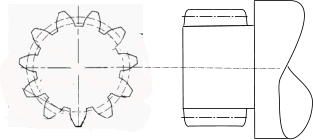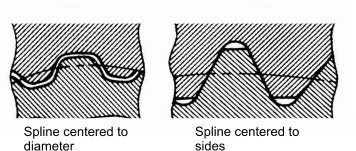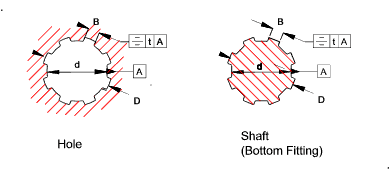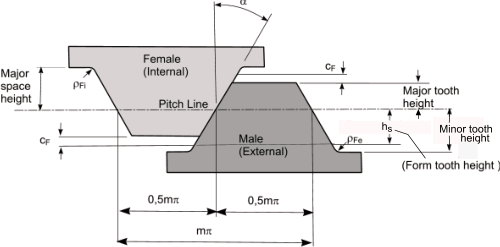Important note:
The information on this page is not detailed and has been obtained by reference to
the relevant BS and Machinerys handbook. Detail design should be completed
using the relevant standards or quality reference sources.
Introduction
The notes and tables below relate to straight cylindrical involute splines
in accordance with BS ISO 4156:2005-1 Straight cylindrical involute splines. Metric module, side fit.
It is emphasised that the splines identified are side fit with the centering based on the sides of the splines
Involute splines are the predominant form bacause they are stronger than straight sided splines
and are easier to cut and the fit. The external spline can be formed either by hobbing or by a gear shaper.
Internal splines are formed by broaching or by a gear shaper. To control tolerances , the minimum
efffective space width and the minimum major diameter of the internal spline are held to basic dimensions . The external spline is varied to
obtain the desired fit.
The very simplest method of initially selecting of involute spline based on a shaft dia is to
arrive at an initial Pitch circle dia (D) and a module (m). eg. a spline for a 50mm OD spline with
say a module of 2mm would have a PCD (D) of 50 - 2 = 48mm. The number of teeth = D/m and as an whole number of
teeth is required a value of D = 48mm is easily selected with number of teeth z =24 teeth. The detailed
manufacturing requirements are obtained using the various notes and tables in the relevant standard / detailed technical
publications. The notes and tables below provide outline information.
The fit of the spline ( interference , close, loose etc ) is primariy specified based on the ISO system of limits and fits as detailed in
BS EN 20286-1/2. Refer to webpage ISO limits..
Shafts connections based on involute splines are suitable for transfering of
high, cyclical and shock torsional moments. Involute splines are used for fixed
and for sliding connections of shafts with hubs..
The splined profile is shaped as involute toothing in the cross section,
with nominal pressure angles of the profile 30�, 37.5� or 45�.
It is centered to the outer diameter or sides of the teeth. Centering to the diameter is more accurate. Centering to sides is
more economical and is used much more frequently in practice.(see figure below )
The groove bottom can be flat or rounded.
BS ISO 4156 is based on the following modules.
For pressure angles of 30� and 37,5� the modules increments are
0,5; 0,75; 1; 1,25; 1,5; 1,75; 2; 2,5; 3; 4; 5; 6; 8; 10
For pressure angle of 45� the module increments are
0,25; 0,5; 0,75; 1; 1,25; 1,5; 1,75; 2; 2,5

Male Involute Spline

Advantages of the involute splines compared with keyways:
Lower pressures than couplings with keys, higher loading capacity of the coupling
Lower wear of sliding couplings
Suitable also for cyclical torsional moments
Easy assembly and disassembly of the coupling
Advantages of involute compared to straight splines
Higher number of teeth resulting in lower pressures and higher loading capacity of the coupling
More uniform distribution of forces along the perimeter
Option of fine adjustment of the hub on the shaft)
Stronger shaft the shaft, lower notch coefficient
Economical lot production using a hobbing method
High accuracy of production similarly as with accurate gears
Disadvantages of the Involute Splines
More complicated to engineer
Higher production costs than couplings with keys
Higher notch coefficient than couplings with keys
Difficult execution of alignment and perpendicularity of the coupling
non-parallelism of sides of the teeth causes additional radial forces in the coupling; these forces then try to open the hub
Standards
BS ISO 4156:2005_1: Straight cylindrical involute splines. Metric module, side fit. Generalities
BS ISO 4156:2005_2: Straight cylindrical involute splines. Metric module, side fit. Dimensions
BS ISO 4156:2005_3: Straight cylindrical involute splines. Metric module, side fit. Inspection
Designation of involute splines
An example set of designations for a mating spline pair with 32 teeth, 2,5 module, with a 30�pressure angle,
a fillet root and a class 5 fit is...
Mating: INT/EXT 32z � 2,5m � 30R � 5H/5f ISO 4156
Internal spline: INT 32z � 2,5m � 30R � 5H ISO 4156
External spline: EXT 32z � 2,5m � 30R � 5f ISO 4156

| Pressure Angle | α | degree (o) |
Pressure Angle
At Pitch Diameter | αD | degree (o) |
| Number of teeth | z | - |
| Module | m | D / z |
| Pitch (Circular) | p | m.π |
Basic Tooth thickness
Circular | S | p/2 |
Basic space width
Circular | E | p/2 |
Effective space width
Circular (minimum) | EV min | p/2 |
| Pitch diameter | D | m.z |
| Base diameter | Db | m� z �cos α D |
| Base pitch | pb | m� π� cos α D |
| Fundamental deviation, external | es v | Tooth mod'n factor -Results from fit (h,f,e,d) see table below |
Minimum major diameter, internal
30�, flat root
30�, fillet root
37,5�, fillet root
45�, fillet root | Dei min |
m� (z + 1,5)
m� (z + 1,8)
m.� (z + 1,4)
m.� (z + 1,2) |
|
Maximum major diameter, internal | Dei max | D ei min + (T + λ ) / tan α D |
Minimum form diameter, internal
30�, flat root &fillet
37,5�, fillet root
45�, fillet root | DFi min |
m� (z +1)+2.cF
m� (z +0,9)+2.cF
m� (z +0,8)+2.cF) |
| Minimum minor diameter, internal | Di i min | DFe max + 2� cF |
Maximum minor diameter, internal:
m =< 0,75
0,75 < m < 2
m > 2 | Di i max |
Dii min + IT 10
Dii min + IT 11
Dii min + IT 12 |
Maximum actual Space width
class 4
class 5
class 6
class 7 | Emax |
EV min + (T + λ)
EV min + (T + λ)
EV min + (T + λ)
EV min + (T + λ)) |
| Minimum actual Space Width | Emin | Ev.min + λ |
| Maximum effective Space Width | EV max | Ev.min + TV |
Maximum major dia external.
30�, flat root & fillet
37,5�, fillet root
45�, fillet root | Dee max |
m� (z +1)+ esv / (tan αD )
m� (z + 0,9)+ esv / (tan αD )
m� (z + 0,8)+ esv / (tan αD ) |
Minimum major diameter, external:
m =< 0,75
0,75 < m < 2
m = > 2 | Dee min |
Dee max - IT 10
Dee max - IT 11
Dee max - IT 12 |
| Maximum form diameter | DFe max |  |
Maximum minor diameter, external
30�, flat root
30�, fillet root
37,5�, fillet root
45�, fillet root | Die max |
m� (z - 1,5)+ esv / (tan αD)
m� (z -1,8)+ esv / (tan αD)
m.� (z - 1,4) + esv / (tan αD)
m.� (z -1,2 ) + esv / (tan αD) |
|
Minimum minor, external | Die min | D ie max - (T + λ ) / tan α D |
|
Maximum effective tooth thickness | S V max | S + esV |
Minimum actual tooth thickness
class 4
class 5
class 6
class 7 | Smin |
SV max - (T + λ)
SV max - (T + λ)
SV max - (T + λ)
SV max - (T + λ) |
| Maximum actual tooth thicknes | S max | Sv.max - λ |
| Minimum effective tooth thickness | S V min | Sv.max - TV |
Total tolerance,
Space width or tooth
thickness | T + λ | See table below |
| Maximum effective clearance | C V max | Ev max - S v min |
| Minimum effective clearance | C V min | Ev min - S v max |
| Form tooth height | h s | See sketch and table for basic rack profile below |
Note: The Form circle is the circle used to define the depth of involute profile control.
In the
case of an external spline it is located near and above the minor diameter, and on an internal spline
near and below the major diameter
Basic Rack Shape

| Parameter | Pressure Angle |
| 30o | 37,5o | 45o |
| Flat root | Fillet root |
| Major Space height | 0,75.m | 0,9.m | 0,7.m | 0,6. m |
| Major Tooth height | 0,5.m | 0,5.m | 0,45.m | 0,4. m |
| Form tooth height (hs | 0,6.m | 0,6.m | 0,55.m | 0,5. m |
| Minor tooth height | 0,75.m | 0,9.m | 0,7.m | 0,6. m |
| Root radius (ρFi ) | 0,2.m | 0,4.m | 0,3.m | 0,25. m |
| Root radius (ρFe ) | 0,2.m | 0,4.m | 0,3.m | 0,25. m |
| Form radius (cF) | 0,1.m | 0,1.m | 0,1.m | 0,1. m |
Table showing tooth thickness modification (esv ) of external splines relative to basic tooth thickness
Important Note: These values are all reductions and so they are negative (-ve) values.
Pitch Dia. D
(mm) |
Selected fit class |
| d | e | f | h |
| Thickness reduction (esv) (mm) |
| = < 3 | 0,020 | 0,14 | 0,006 | 0 |
| 3 to 6(inc) | 0,030 | 0,020 | 0,010 | 0 |
| 6 to 10(inc) | 0,04 | 0,025 | 0,013 | 0 |
| 10 to 18(inc) | 0,05 | 0,032 | 0,016 | 0 |
| 18 to 30(inc) | 0,065 | 0,040 | 0,020 | 0 |
| 30 to 50(inc) | 0,080 | 0,050 | 0,025 | 0 |
| 50 to 80(inc) | 0,10 | 0,060 | 0,030 | 0 |
| 80 to 120(inc) | 0,12 | 0,072 | 0,036 | 0 |
Table showing total Tolerance (T + λ) for Space width and Tooth thickness
The Total Tolerance (T + λ) is the sum of the Machining Tolerance (T)
and the Effective variation (λ)
| Spline Tolerance class(T + λ) | Formula for (T + λ) | formula for i1 & i2 |
| 4 | 10i1 + 40i2 | i 1 = 0,001[0,453.Sqrt (D) +0,001D ]
i 2 = 0,001[0,453.Sqrt (S +0,001 S ]
Note: i 1 applies for D < 500mm |
| 5 | 16i1 + 64i2 |
| 6 | 25i1 + 100i2 |
| 7 | 40i1 + 160i2 |
The effective variation is the combined effect of the total index variation (Fp ), the positive profile variation
(ff ) and the tooth alignment variation ( F β ) . These combined effect i
for convenience calculated using the following equation

Table showing equations for (Fp ), ( ff ) and ( F β )
Spline
Tolerance class | Fp | ff | F β |
| 4 | 0,001.[ 2,5 Sqrt(M.z.β /2 ) + 6,3] | 0,001 [1,6.m (1+0,012z) + 10] | 0,01 [0,8.sqrt(g) + 4] |
| 5 | 0,001.[ 3,55 Sqrt(M.z.β /2 ) + 9] | 0,001 [2,5.m (1+0,012z) + 16] | 0,01 [1,0.sqrt(g) + 5] |
| 6 | 0,001.[ 5 Sqrt(M.z.β /2 ) + 12,5] | 0,001 [4.m (1+0,012z) + 25] | 0,01 [1,25.sqrt(g) + 6,3] |
| 6 | 0,001.[ 7,1 Sqrt(M.z.β /2 ) + 18] | 0,001 [6,3.m (1+0,012z) + 40] | 0,01 [2,0.sqrt(g) + 10] |
Table showing values for esv / (tan αD ) for different Pressure angles and Fites
Pitch Dia.
D (mm) |
α = 30 | α = 37,5 | α = 45 |
α = 30 | α = 37,5 | α = 45 |
α = 30 | α = 37,5 | α = 45 |
α = All |
| fit class = d | fit class = e | fit class = f | fit class = h |
| esv / (tan αD ) - (mm) |
| =< 3 | 0,035 | 0,026 | 0,020 | 0,024 | 0,018 | 0,014 | 0,010 | 0,008 | 0,006 | 0 |
| 3 to 6 inc. | 0,035 | 0,039 | 0,030 | 0,035 | 0,026 | 0,020 | 0,017 | 0,013 | 0,010 | 0 |
| 6 to 10 inc. | 0,052 | 0,052 | 0,040 | 0,043 | 0,033 | 0,025 | 0,023 | 0,017 | 0,013 | 0 |
| 10 to 18 inc. | 0,069 | 0,065 | 0,050 | 0,055 | 0,042 | 0,032 | 0,028 | 0,021 | 0,016 | 0 |
| 18 to 30 inc. | 0,087 | 0,085 | 0,065 | 0,069 | 0,052 | 0,040 | 0,035 | 0,026 | 0,020 | 0 |
| 30 to 50 inc. | 0,113 | 0,104 | 0,080 | 0,087 | 0,065 | 0,050 | 0,043 | 0,033 | 0,025 | 0 |
| 50 to 80 inc. | 0,139 | 0,130 | 0,100 | 0,104 | 0,078 | 0,060 | 0,052 | 0,039 | 0,030 | 0 |
| 80 to 120 inc. | 0,173 | 0,156 | 0,120 | 0,125 | 0,094 | 0,072 | 0,062 | 0,047 | 0,036 | 0 |
| 180 to 250 inc. | 0,208 | 0189 | 0,145 | 0,147 | 0,111 | 0,085 | 0,074 | 0,056 | 0,043 | 0 |
| 250 to 315 inc. | 0,251 | 0,222 | 0,170 | 0,173 | 0,130 | 0,100 | 0,087 | 0,065 | 0,050 | 0 |
| 315 to 400 inc. | 0,294 | 0,248 | 0,190 | 0,191 | 0,143 | 0,110 | 0,097 | 0,073 | 0,056 | 0 |
|




